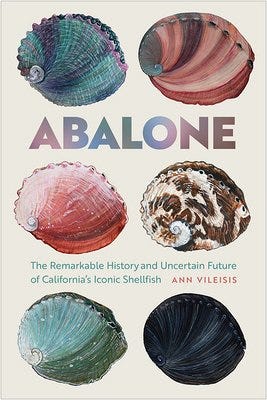We were at a Chinese restaurant, most likely for a special occasion or banquet, because course after course was just showing up. My mother beamed when she tasted the soup that she’d just been served. “It’s abalone,” she informed me. “Very expensive. A luxury.” I watched, fascinated, as she slowly finished her bowl, ignoring all the other courses. I was just a child, but the way she savored that soup imprinted abalone in my memory as a unique food.
***
I spent the last week of July in California, and since I like to match my reading to my travels, I decided it was an opportune time to read Ann Vileisis’ “Abalone: The Remarkable History and Uncertain Future of California’s Iconic Shellfish” (Oregon State University Press). A 2021 Oregon Book Award finalist for nonfiction, the book delves deep into what the author calls “human-molluscan history,” noting the mostly unsung role that abalone have played in the California story.
Abalone sparked the earliest calls for conservation in California, yet were given reprieve only with the impetus of racial prejudice. Abalone inspired bohemian writers’ poetry, California cuisine, and the sport of skin diving, yet also provoked fierce and intractable conflicts over limits on their use.
… Only by knowing a history that integrates these intertwining cultural and ecological threads can we better understand what has happened to the abalones and why they urgently need our attention now.
Vileisis collects stories from older Californians who remember a time when abalone were so plentiful that they were anything but a gourmet delicacy reserved for special occasions. But, as with so many other things, the abalone’s popularity proved its undoing. The shellfish became overfished, and efforts to save it met with so much dissension and dithering that they were almost worse than doing nothing at all.
***
I texted a friend who’d grown up in northern California that I was reading a book about how California was once the Abalone Capital but had let all of its abalone get overfished and die out.
My friend replied: “I remember learning about the collapse of the local abalone industry in school. A lot of the shellfish harvesting and processing took place in the Monterey/Salinas area, hence Cannery Row, etc.”
I had read John Steinbeck’s 1945 novel “Cannery Row” during a Steinbeck phase in my teens, but never made the connection to abalone — perhaps it’s time to revisit that book. Meanwhile, the way Vileisis tucks a whole history within the abalone’s shell makes me think a similar book could be written about the intertwined stories of salmon and another cannery row, in Astoria on the north Oregon coast. I wonder how much of that history is being taught in Oregon coast schools.
***
“Abalone” can occasionally turn dry, especially in slightly overly detailed re-tellings of bureaucratic sniping. But Vileisis held my attention by repeatedly producing fascinatingly detailed descriptions of abalones’ lives and surprisingly dramatic moments in marine biologists’ efforts to save those lives. During a walk around the neighborhood with my husband, I couldn’t resist telling him about one scene in the book in which a researcher-diver transporting a bag of carefully nurtured abalone finds himself fending off an attack by a hungry ray. Those little shellfish, and their human champions, just couldn’t catch a break.
Vileisis closes her cautionary tale about a species we’ve loved to near-death on a hopeful note. Afterward, I did a quick online search. It turns out there are still restaurants that serve abalone, though often at high prices. And it turns out abalone is now being farmed sustainably enough in California and elsewhere to be listed as a “best choice” on the Monterey Bay Aquarium’s respected Seafood Watch Guide, a helpful reference for those who want to make choices that support a healthy ocean.
A happy ending, of sorts.


